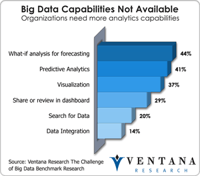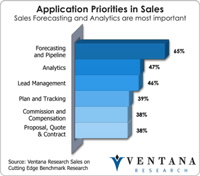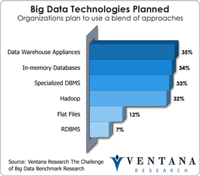Predictive analytics has the potential to help businesses increase the impacts of their actions by creating indicators that represent future outcomes based on existing behavior. This process becomes more complicated when they have to apply predictive analytics to what we call big data environments. As yet only 13 percent of organizations are using predictive analytics according to our business analytics benchmark research, although 37 percent indicated that predictive capabilities are very...
Read More
Topics:
Big Data,
Predictive Analytics,
Opera Solutions,
IT Performance,
Business Analytics,
Business Collaboration,
Business Intelligence,
Business Mobility,
Business Performance,
Business Technology,
CIO,
Cloud Computing,
Information Applications,
Information Management,
Information Technology,
Operational Intelligence
Read More
Topics:
Sales Performance,
SAP,
Human Capital Management,
Mobile Technology,
Business Analytics,
Business Mobility,
Business Performance,
Business Technology,
CIO,
Cloud Computing,
Customer & Contact Center,
Financial Performance,
Information Management,
Information Technology
Informatica has announced a major release, version 9.5, of its software platform, which will be generally available in June. The company’s data integration technologies will support the new generation of computing that includes big data, cloud computing, mobile and social media. These computing environments, which our firm has defined as key business technology drivers for this decade, have a compelling impact on the data that enterprises create and use. Being smart about integrating and...
Read More
Topics:
Big Data,
Supply Chain Performance,
Mobile Technology,
IT Performance,
Business Analytics,
Business Intelligence,
Business Mobility,
Business Performance,
Business Technology,
CIO,
Cloud Computing,
Customer & Contact Center,
Financial Performance,
Governance, Risk & Compliance (GRC),
Informatica,
Information Applications,
Information Management,
Information Technology,
Strata+Hadoop
With the release of Business Analytics version 4.5, Pentaho has expanded its platform and tools to address the needs of business and IT. The product has come a long way since the version 4 release less than a year ago, which broke ground in ease of use and support for big-data sources. Advancing beyond its roots in business intelligence, Pentaho Business Analytics 4.5 addresses data discovery, data integration and data mining and provides visual discovery and analytics that operate against...
Read More
Topics:
Big Data,
Pentaho,
Supply Chain Performance,
Mobile Technology,
IT Performance,
Business Analytics,
Business Intelligence,
Business Mobility,
Business Performance,
Business Technology,
CIO,
Cloud Computing,
Customer & Contact Center,
Financial Performance,
Governance, Risk & Compliance (GRC),
Information Applications,
Information Management,
Information Technology,
Strata+Hadoop
Making business use of the vast amount of information on the Web and Internet along with a company’s intranet is no easy task. Kapow Software aims to help by providing tools to define and virtualize access to information, integrate it with other information, such as that in databases, and present it in a useful format. The tool can supply access to data from legacy applications such as PeopleSoft and Siebel, newer applications from Oracle and SAP and applications in cloud computing...
Read More
Topics:
Big Data,
Supply Chain Performance,
Mobile Technology,
IT Performance,
Business Analytics,
Business Intelligence,
Business Mobility,
Business Performance,
Business Technology,
CIO,
Cloud Computing,
Customer & Contact Center,
Financial Performance,
Governance, Risk & Compliance (GRC),
Information Applications,
Information Management,
Information Technology,
Kapow,
Strata+Hadoop
Business intelligence software is increasingly mobile, becoming available via smartphones and tablets and now enabling planning and what-if scenarios to determine the impacts of changes that might be made to improve performance. InetSoft, which has been providing business intelligence tools for more than 15 years, has advanced its technologies to address these trends. The company recently announced version 11.2 of InetSoft Style Intelligence, adding many new capabilities. Among them, the...
Read More
Topics:
Sales Performance,
IT Performance,
Business Analytics,
Business Intelligence,
Business Performance,
Business Technology,
CIO,
Cloud Computing,
Financial Performance,
InetSoft,
Information Applications,
Information Management,
Information Technology
Thanks to Datawatch, businesses may find themselves buying and deploying fewer new business analytics and business intelligence tools. As I noted in my analysis last year, the company’s new management has begun to transition it to a more appealing market position in which it helps enterprises use analytics to improve operational efficiency and decision-making. The Datawatch products focus on data virtualization – that is, accessing data from multiple sources not usually seen as accessible for...
Read More
Topics:
Supply Chain Performance,
IT Performance,
Business Analytics,
Business Intelligence,
Business Performance,
Business Technology,
CIO,
Cloud Computing,
Customer & Contact Center,
Financial Performance,
Governance, Risk & Compliance (GRC),
Information Applications,
Information Management,
Information Technology,
Datawatch
Splunk recently entered the financial markets as a publicly traded company (NASDAQ: SPLK) and also entered a new phase in its corporate growth. Splunk combines the power of search and discovery with analytics on data generated by IT systems, that they call machine data, and provide insight for a new generation of operational intelligence that helps everyone in IT including the CIO determine the efficiency of its systems that support business. The company has built a platform that can index data...
Read More
Topics:
Big Data,
Social Media,
Supply Chain Performance,
Splunk,
IT Performance,
Operational Performance,
Business Analytics,
Business Collaboration,
Business Intelligence,
Business Mobility,
Business Performance,
Business Technology,
CIO,
Cloud Computing,
Customer & Contact Center,
Financial Performance,
Governance, Risk & Compliance (GRC),
Information Applications,
Information Management,
Information Technology,
IT Analytics,
Location Intelligence,
Machine data,
Operational Intelligence,
Strata+Hadoop
Through a series of acquisitions and organic development over the last five years, IBM has established itself as a leader in enterprise big data for business analytics. I recently wrote about IBM Smarter Analytics, which brings together the company’s portfolio of software, systems and services from analytics to big data. But supporting big data requires the ability to access many sources of information; our benchmark research on big data found that more than half of organizations require...
Read More
Topics:
Big Data,
Sales Performance,
Social Media,
Supply Chain Performance,
Sustainability,
Vivisimo,
IT Performance,
Business Analytics,
Business Collaboration,
Business Intelligence,
Business Mobility,
Business Performance,
Business Technology,
CIO,
Cloud Computing,
Cloudera,
Customer & Contact Center,
Financial Performance,
Governance, Risk & Compliance (GRC),
IBM,
Information Applications,
Information Management,
Information Technology,
Location Intelligence,
Operational Intelligence,
Workforce Performance,
Strata+Hadoop
Read More
Topics:
Big Data,
Datameer,
Sales Performance,
Social Media,
Supply Chain Performance,
Sustainability,
IT Performance,
Business Analytics,
Business Collaboration,
Business Intelligence,
Business Mobility,
Business Performance,
Business Technology,
CIO,
Cloud Computing,
Customer & Contact Center,
Financial Performance,
Governance, Risk & Compliance (GRC),
Information Applications,
Information Management,
Information Technology,
Location Intelligence,
Operational Intelligence,
Workforce Performance,
Strata+Hadoop











